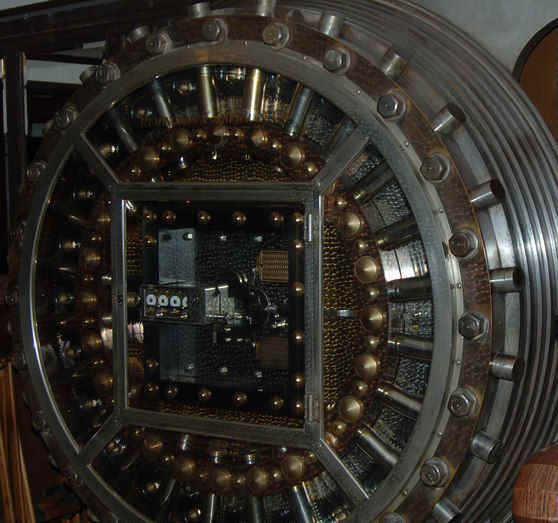Yale & Towne Manufacturing Co., Stamford, Connecticut - 4 movements, Quad-M, v.1, v.2 with "throw off flag" option
A
B
A. Quad-M, v.1, c. 1899. This was Yale's biggest and heaviest manual bolt work time lock using the companies' largest movements, the "M" size. Weighing in at twenty two pounds it was for use in the largest vault doors, see photo below. This example, version 1, had the full glass door panel which was replaced by 1908 with the half-glass design due to the easy breakage of the glass from careless winding. The change in glass design distinguishes the v.1 from the v.2 across much of Yale's early product line; and can be seen in the Triple L, P, Quad N, for automatic bolt motors and Triple K and O for conventional bolt work. This example was introduced in 1899 and was advertised to have a combined pull exceeding seventy pounds. It was a bit of an odd promotion since the Quad M did not depend on the movements to "pull" anything. It was sold for use with hand operated bolt works only and simply dropped the side release block within the case. This model as well as some others in the Yale line included an option which Yale advertised as a "throw off flag" visible though the case door to the side of the movements. The mechanism allowed the lock to be wound and set but not actuated when the vault door is locked with the combination lock during the business day. Once the OPEN lever is thrown up, the time lock will secure the door when it is closed and locked. See video demonstration of this device. This feature appeared on the Holms Electric time lock and also as the Infallible Chronometric Attachment™ in the Hall and later Consolidated Time Lock Company time locks. (1) The fact is that this model was scaled up to match the size of the larger vault doors. It would not look good for a massive door to depend upon a 'dinky' time lock to guard it even if this was a perfectly effective design. Appearance, decoration and promotion was a big part of the industry at this time; an impressive presentation to the customer played a large part in the design of time locks. The profit margins were large and so patent litigation was key, as it is today, to keep out competitors. Yale made 109 of the early nickel plated model shown here and only two are known to survive.(2) 11 3/4"w x 5 1/2"h x 3 1/4"d. Case #57, movement #2482, 3988, 3989, 3990. file 145
B. Quad-M, v.2, c. 1908. Same model lock as above but with half-glass door panel which eliminated breakage of the glass insert that change was the v.2 change. The scoring marks next to each winding hole are a testament to this issue. There was a significant design change between this model and the previous versions. Here the snubber bar does not actuate against an external lever that is connected to the bolt dog as can be seen in the v.1 models. In the v.2 that actuator is placed behind the front plate and so the snubber bar now has a square keyed mount behind the right hand lower bolt that actuates the bolt dog. This change was carried through the rest of their product lines for manual bolt work safes in their Triple K and Triple O series. This model is in a brass machined case finish Yale dubbed the 'bronze wave'. Twenty five of this style are known to have survived. This example has all original consecutively number movements, a rare event with a four movement lock. 11 3/4"w x 5 1/2"h x 3 1/4"d. Case #157, movement #3578, 3579, 3580, 3581. file 153
The first two photos below show large round vault doors equipped with a Yale Quad M similar to that shown in examples A and B.

The two photos below show Yale Quad M time locks mounted in a vault doors made by Mosler and York Safe Co., respectively. One would be forgiven for thinking that the blank time lock box in the first photo may have been for an optional additional Yale quad M time lock, making for eight time locks in a door, certainly a record! But the second photo reveals that the left hand time lock case is simply a cover for the components that are normally seen connecting the combination lock units. Look carefully and you will see the case bolt holes of both cases are matching up between the two boxes and that slide bolt runs all the way from the left hand upper corner of the protective case where it connects to the combination lock work through to the actual time lock where it is controlled by that unit. Perhaps this arrangement was used to give a nice symmetric presentation to the door. Note that this Quad M example does not have the throw off flag option.

The two photos below were taken from an abandoned bank in Alabama. The City Federal Savings and Loan. While the rest of the vault door was quite rusty, the glass encasement kept the time lock assembly relatively safe. The unusual thing to note here is the brass finish on the the time lock case. It is identical to that seen on the Holler time locks, and before this example I have never see this used on a Yale branded lock.


(1)
American Genius Nineteenth Century Bank Locks and Time Locks, David Erroll & John Erroll, pg. 294, (2) pg. 295